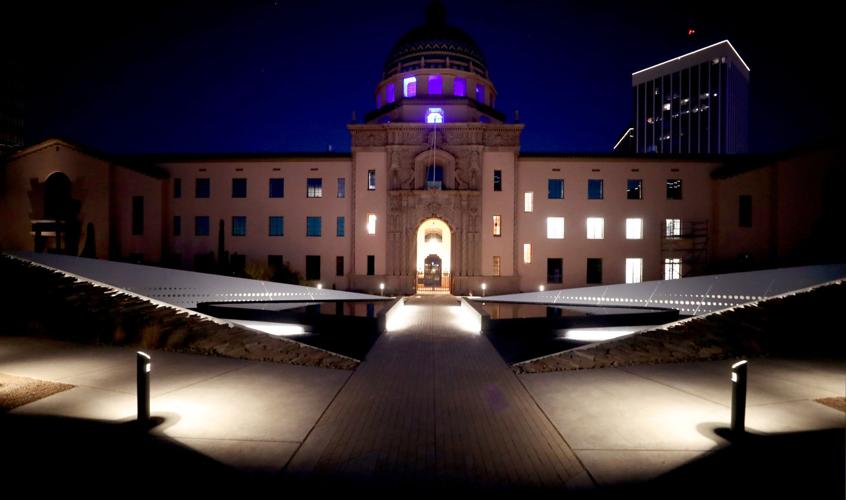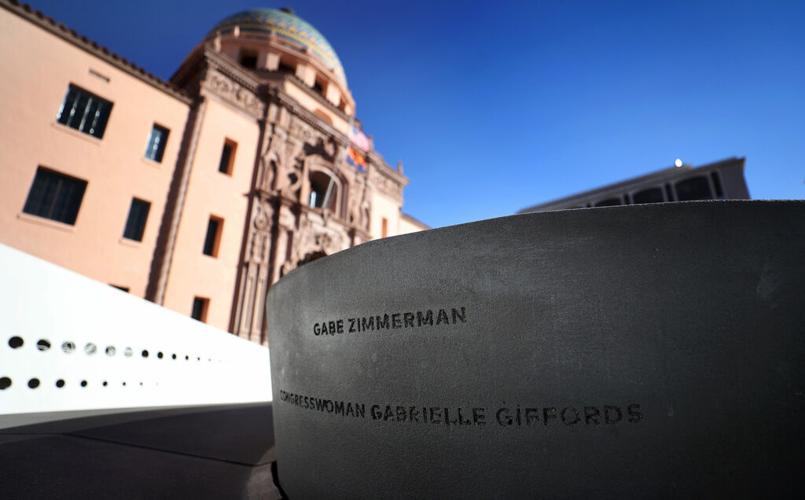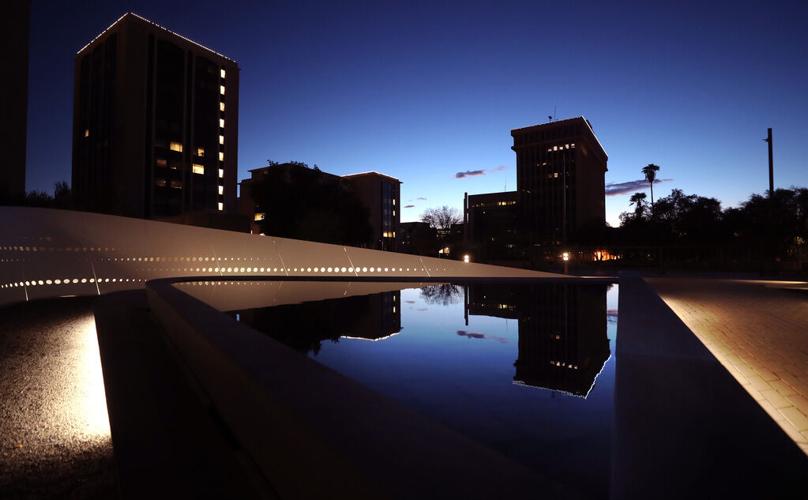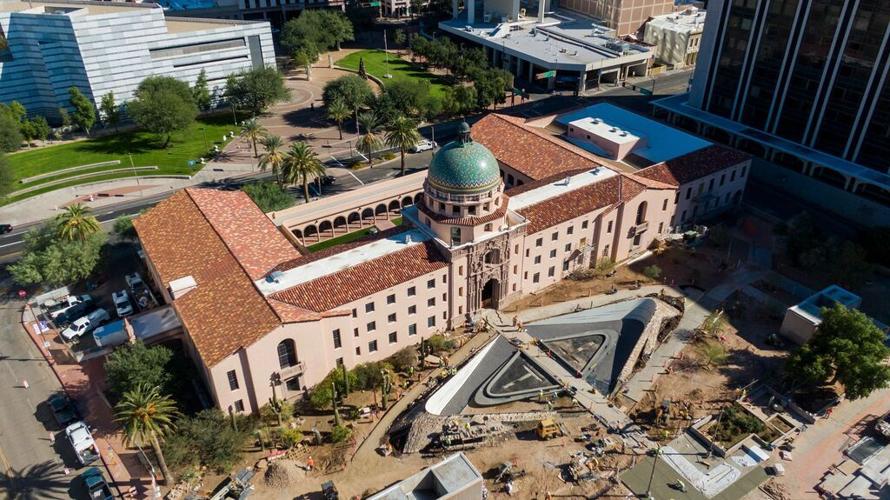From a central walkway, the gravel path angles downward into a curved sweep of light gray metal that seems to rise up to meet you as you approach it.
Rocks crunch under your feet as you move past a reflecting pool to study rows of circular symbols in the steel wall in front of you at the January 8th Memorial.
The January 8 Memorial, "The Embrace", will open on the anniversary of the mass shooting in 2011 to commemorate the 19 victims. The memorial is on the west side of the Old Pima County Courthouse in El Presidio Park. Video by Kelly Presnell / Arizona Daily Star 2020
The downtown memorial to the Tucson shooting is known as “The Embrace,” and you’re meant to feel like you’re inside of it when you’re there.
“As you descend, the memorial starts to surround you,” said architect Marc Salette from the design team behind the project. “The sound of the city is going to recede, and while you’re still in the heart of El Presidio Park, you’re surrounded by the story of January 8th.”

Evening falls over “The Embrace,” the new January 8th Memorial on the west side of the Old Pima County Courthouse in El Presidio Park. A small, pandemic-safe dedication ceremony will be held at the downtown site Friday to mark the 10th anniversary of the attack.
The newly finished memorial is nestled along the west side of the historic Pima County Courthouse, where almost an acre of gardens and paths surround a pair of curved steel walls separated by matching pools.

Workers are reflected in the north pool as final touches get installed on the new January 8 Memorial, "The Embrace", outside the Old Pima County Courthouse.
The names of those killed and wounded in the mass shooting 10 years ago today are carved into the pools’ concrete walls. Their stories are told with modern-day petroglyphs, cut from the steel panels — a judge’s gavel, a little girl’s butterfly, a Capitol dome for a congresswoman.
The memorial was conceived and developed by the nonprofit January 8th Foundation, which collected more than $2.6 million in community donations to pay for the project.

The evening sun sets over El Presidio Park and the south reflecting pool of "The Embrace".
Pima County provided the land and prepared the site for construction, including utility work and an archaeological dig that recovered artifacts from a wide swath of Tucson’s past.
Husband-and-wife architects Salette and Tina Chee designed “The Embrace” with visual artist Rebeca Méndez, researcher Jackie Kain and lighting consultants agLicht.
Salette said hundreds of people have worked on the project, most of them from Tucson. “It’s the work of a team, and the team gets bigger and bigger and bigger,” he said.
The memorial remains closed to the public until at least February due to coronavirus restrictions. A small, pandemic-safe dedication ceremony will be held at the site Friday to mark the 10th anniversary of the attack.

The northern pool and the southern wall of the new January 8 Memorial, "The Embrace", outside the Old Pima County Courthouse.
“Conscious decision” to leave carnage out
Congresswoman Gabrielle Giffords was meeting with constituents in a grocery store parking lot on Jan. 8, 2011, when a lone gunman opened fire at the “Congress on Your Corner” event in northwest Tucson.
Six people were killed: Christina-Taylor Green, 9; Dorothy Morris, 76; U.S. District Judge John M. Roll, 63; Phyllis Schneck, 79; Dorwan Stoddard, 76; and Gabe Zimmerman, 30.
Thirteen others were shot but survived — Giffords, Bill Badger, Ron Barber, Ken Dorushka, James Eric Fuller, Randy Gardner, Suzi Hileman, George Morris, Mary Reed, Pam Simon, Mavanell Stoddard, Jim Tucker and Kenneth Veeder.
No explicit details about the shooting appear in the new memorial. The gunman’s name is nowhere to be found. His actions are hinted at but not explained, assuming they even could be.

Six people were killed in the mass shooting at the Safeway at Ina and Oracle roads on Jan. 8, 2011. Top row, from left: Dorothy “Dot” Morris, 76; John Roll, 63; Christina-Taylor Green, 9. Bottom row, from left: Phyllis Schneck, 79; Gabriel “Gabe” Zimmerman, 30; Dorwan Stoddard, 76.
Former foundation executive director Crystal Kasnoff said excluding such information was a “conscious decision” by the foundation board and those who guided them, namely the people who survived the attack and the families of those who didn’t.
They wanted a project that would honor the victims and celebrate the community’s response, without reliving the event itself.
Pam Simon, who was wounded while working as her friend Gabby’s community outreach coordinator that day, thinks “The Embrace” achieves that goal.
“It really truly is a memorial to how our town came together. People tripped over themselves to be helpful and to try to make some good come out of what happened,” the former school teacher turned gun-safety advocate said. “A hundred years from now, a person visiting the memorial will know the community came together around a tragedy.”
A new language for remembrance
Some factual details about the mass shooting are included in the memorial’s companion website, which visitors can access by scanning a QR-code with their smartphones, even if they can’t yet visit the site itself.
The website also includes a detailed guide to all the symbols used throughout “The Embrace.”
The laser-cut figures — seven each for those who died, five each for those who survived — are arranged in rows the designers describe as constellations. Each constellation is comprised of 33 holes, one for every bullet fired that morning.

Pima County has launched a companion website for the January 8th Memorial with information about the project and those impacted by the shooting. It includes a detailed key for interpreting the more than 100 symbols used in the memorial. Scan this QR code with your smart phone to reach the website or use the link https://visitsouthernarizona.com/january-8th-memorial/.
The idea was not to hide from what happened, but to incorporate it, said Rebeca Méndez, the artist who created the symbols. Gunfire perforated the fabric of the community, so the memorial fills some of those voids with the stories of the victims, almost like stitching up a wound.
Méndez’s work was informed by interviews with the families and inspired by the centuries-old figures etched by the Hohokam people in the rocks surrounding Tucson.
She produced roughly 200 unique characters, 102 of which made it into the final product.
The figures are designed so visitors can take embossed impressions of them by covering them with paper and gently rubbing them with their finger.

Symbols etched into the January 8th Memorial’s walls represent the victims and survivors of the shooting. Above, underneath a symbol for the name of the memorial “The Embrace,” seven symbols align to represent Christina-Taylor Green. A website, launched by Pima County, includes a detailed guide to all the symbols used throughout the memorial.
In addition to symbols for the victims and survivors, there are 32 figures depicting important moments from Tucson history. Those can be found atop the bollards that light the paths through the memorial. The symbols tell the community’s story from its earliest indigenous inhabitants to the arrival of the Central Arizona Project canal carrying water from the Colorado River.
They were chosen after extensive research and consultation with local tribes by Jackie Kain, who oversaw community outreach as well as historical and cultural interpretation for the project.
Some of the moments depicted are harsh, even bloody, Méndez said, but they speak to “the history of resilience in the city of Tucson.”

Progress on the January 8 Memorial as seen from the air over Presidio Park and the historic Pima County Courthouse on Nov. 25, 2020.
Building up from a solid foundation
Planning for a Jan. 8th Memorial began within a few months of the shooting.
Former Congressman Ron Barber, then Giffords’ district director, organized the first meeting late that spring, while he was still recovering from his own gunshot wounds.
Simon said she was one of maybe 60 people in attendance for that initial brainstorming session held in a conference room at Cox Communications.
The foundation was officially launched early the next year by a smaller group of about 10 people, including Simon, Barber and Ross Zimmerman, Gabe’s father.
Zimmerman said his motivation to participate was easy: “If Gabe had been around, he would have been heavily involved in it.”

The names of two victims, Gabe Zimmerman and Gabrielle Grffords, are etched on the tip of the northern fountain and reflecting pool, part of the new January 8 Memorial outside the Old Pima County Courthouse.
To help sketch out their plans, members toured other national memorials — the Sept. 11 memorial in New York City, Oklahoma City, Columbine and the Flight 93 Memorial in Pennsylvania — and sought guidance from some of the people responsible for those projects.
“One of the things most of them said was ‘don’t rush the process,’” Simon said.
Another piece of advice they got: Never stop talking to stakeholders and the public. “If you don’t have consensus in your community, you can end up with something that doesn’t fit,” Zimmerman said. Or worse, that alienates the people you are trying to honor.
Agreeing on a site was one of the biggest challenges the foundation faced. Some thought it should be at or near the Safeway shopping center at Oracle and Ina where the shooting occurred. Others suggested a series of dispersed memorials scattered along the Loop, Tucson’s 130-mile multiuse trail network.

"The Embrace", the new January 8 Memorial outside the west side of the Old Pima County Courthouse.
The memorial eventually landed in exactly the right place, as far as Pima County Administrator Chuck Huckelberry is concerned.
El Presidio Plaza is the historic center of government and culture in Tucson, he said, a place where people have long met to share ideas and engage in the democratic process.
“That is what Congresswoman Giffords was doing (that day): bringing government to the people,” Huckelberry said.
The attack on her felt like an attack on all of Tucson, he said.
A broken chain made whole again
Viewed from above, the January 8th Memorial resembles a broken link of chain fused back together by a shaft of light.
The pools and memorial walls form the inside of the link, and two living walls clad in rock and desert plants form the outside. The shaft of light is the central walkway, a ribbon of concrete trapezoids that connects the memorial to the courthouse and the rest of the plaza.
That shape is no accident. Tina Chee said it was inspired by a chain made of paper and left at one of the spontaneous memorials that sprang up in Tucson immediately after the shooting.
The overall theme of the project came from workshops the design team had with the survivors and the victims’ families. “We could really feel the sense of community, how, in the aftermath, people were coming together,” Chee said. It felt like an embrace.
That’s how the Chee Salette team won the job during the 2015 design contest, conducted by the foundation and what was then known as the Tucson Pima Arts Council.
About 60 artists and architects from across the country applied to participate. Four firms, including one from Tucson and one from Tempe, were chosen as finalists and given two months to submit their proposals.
All of the designs were impressive, Pam Simon said, but only “The Embrace” captured the tone the foundation was trying to achieve. “We knew right away,” she said.
There are now 19 commemorative trees growing throughout the memorial site — an ironwood for each victim and a Sonoran palo verde for each survivor.

In the days after the Jan. 8 shooting in 2011, spontaneous memorials sprang up around Tucson, including this large memorial on the front lawn of University Medical Center, where Rep. Gabrielle Giffords and other victims were being treated.
The six who died also have their own gardens at the site, with plants that reflect their lives —flowers to attract butterflies for Christina-Taylor Green, edible plants that Phyllis Schneck might have used in her cooking, a patch of saguaros for Tucson native and fourth-generation Arizonan Dorwan Stoddard.
And what about Zimmerman’s son, the congressional staffer who loved the outdoors? “Gabe’s corner is a nice little trail with some sitting rocks,” Zimmerman said.
Windows of water and a shadowy surprise
Every detail of the memorial has been carefully planned and fussed over, from the color and pattern of the slate in the living wall to the consistency of the gravel on the paths around the reflecting pools.
One feature in particular is still being fine-tuned.
The recirculating pools are designed to overflow in a precise way that sends a thin sheet of water down to the bench below. The water spills in front of the names carved there but does not touch them.
Chee said the effect is difficult to achieve but mesmerizing in a way even she wasn’t prepared for. The first time they got the cascade just right, she said it was “one of the most beautiful things we had seen.”
“The way it comes down, it’s so clear that you almost can’t believe that it’s water,” Chee said.
Also unexpected is the way the sun plays off of Méndez’s symbols, casting shadows that move across the memorial wall and sometimes overlap.
“To see a Hohokam bird with the shadow of an airstrip and plane behind it, it really spans the whole history of Tucson,” Méndez said.
“I should say, of course I knew (they would do that),” she added with a laugh, “but it was a beautiful, beautiful surprise.”

Evening falls over “The Embrace,” the new January 8th Memorial on the west side of the Old Pima County Courthouse in El Presidio Park. A small, pandemic-safe dedication ceremony will be held at the downtown site Friday to mark the 10th anniversary of the attack.
One volunteer group giving way to another
With the project now finished, the January 8th Foundation has begun the process of closing up shop.
Kasnoff said the board will likely be disbanded after it collects its last few pledged donations for upkeep of the memorial.
After that, she expects the foundation to fade away, only to be replaced by an exciting new crop of volunteers. Kasnoff said she has already heard from people who are interested in becoming stewards or docents at “The Embrace.”
In the meantime, efforts continue to get Congress to declare the site a national memorial, a designation that would likely bring increased status and visitation through a connection to — but not ownership by — the National Park Service.
Arizona’s congressional delegation introduced bills to that effect in 2017 and 2020, but so far the legislation has failed to advance.
Zimmerman expects that to change.
“It (commemorates) an event that’s unique in U.S. history,” he said. “It makes all the sense in the world that it should be a part of the Park Service’s inventory of important places.”
An emotional tour for those who were there
On Dec. 8, project officials conducted a series of private tours for small groups of survivors, family members and others with direct ties to the memorial.
The foundation’s Crystal Kasnoff said it was an “incredibly touching” and difficult day. “People were solemn. They were incredibly kind. They were incredibly grateful. And they were with family,” she said.
It was Simon’s first visit to the completed memorial, and it took her breath away.
“For so long, it was a hole in the ground, and then all of a sudden there it was,” she said. “I always knew we would get it done, but to finally see it was pretty wonderful.”
The thing that struck her the most, even though she had seen it in drawing after drawing, was the colorful courthouse dome shining back at her from the surface of the pools.
“I think the goal was for the memorial to reflect the community, and there it was in physical form,” she said.
Pat Maisch wasn’t shot on Jan. 8, 2011, but she did sustain emotional trauma as she helped to disarm the gunman.
Since then, she has campaigned tirelessly — and often loudly — for gun safety reforms. Her advocacy has twice landed her in trouble on Capitol Hill, once for a 2016 sit-in at the rotunda and once for shouting “Shame on you” from the Senate gallery after the defeat of a 2013 gun-control bill.
Maisch said the Tucson shooting “seems like forever ago, and it seems like a minute ago.”

A garden in the name of victim Dorwan Stoddard includes several imported saguaros to represent his love of the Sonoran desert as part of the new January 8 Memorial outside the Old Pima County Courthouse.
In some ways, the pain has gotten easier to deal with over the past 10 years. In other ways, she said, it has gotten worse. Most of the people in the parking lot that day were strangers to her. Now she is friends with them or with the people they left behind.
“I feel their pain more now because I know these people,” Maisch said.
She expected her tour of the memorial on Dec. 8 to be emotional, and it was.
“It was touching to see their names and their symbols,” Maisch said of the people with whom she shares “The Embrace.” “To be able to physically touch their names, that was very touching to me.”

















